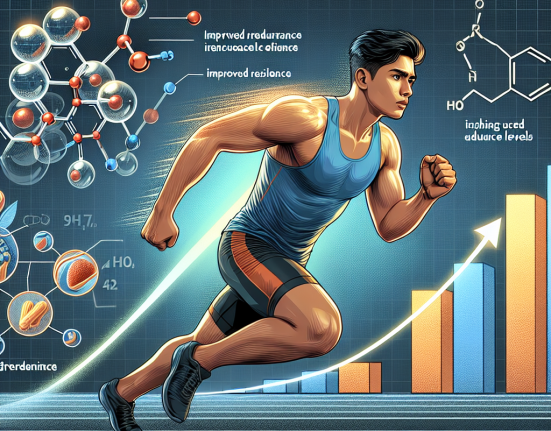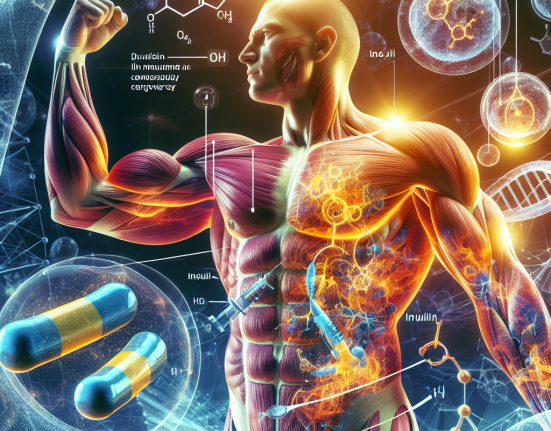-
Table of Contents
Viagra: Enhancing Physical Endurance in Sports
Viagra, also known as sildenafil, is a well-known medication primarily used to treat erectile dysfunction. However, in recent years, it has gained attention in the sports world for its potential to enhance physical endurance. This article will explore the pharmacokinetics and pharmacodynamics of Viagra and its effects on athletic performance.
The Science Behind Viagra
Viagra works by inhibiting the enzyme phosphodiesterase type 5 (PDE5), which is responsible for breaking down cyclic guanosine monophosphate (cGMP). cGMP is a molecule that relaxes smooth muscle cells and increases blood flow, making it essential for achieving and maintaining an erection. By inhibiting PDE5, Viagra allows cGMP to accumulate, resulting in improved blood flow to the penis and a sustained erection.
But how does this mechanism of action translate to athletic performance? Studies have shown that Viagra can also increase blood flow to other parts of the body, such as muscles, which can improve physical endurance and performance.
Pharmacokinetics of Viagra
Viagra is rapidly absorbed after oral administration, with peak plasma concentrations reached within 30-120 minutes. The bioavailability of Viagra is approximately 40%, meaning that 40% of the drug reaches the systemic circulation. It is primarily metabolized by the liver and excreted in the urine, with a half-life of approximately 4 hours.
It is important to note that the pharmacokinetics of Viagra can be affected by various factors, such as age, liver function, and concomitant use of other medications. Therefore, it is crucial for athletes to consult with a healthcare professional before using Viagra for performance enhancement.
Pharmacodynamics of Viagra
The pharmacodynamics of Viagra are closely linked to its mechanism of action. By inhibiting PDE5, Viagra increases the levels of cGMP, leading to vasodilation and increased blood flow. This effect is not limited to the penis but can also occur in other parts of the body, such as muscles.
Studies have shown that Viagra can improve exercise capacity and delay the onset of fatigue in both trained and untrained individuals. This is due to the increased blood flow to muscles, which allows for better oxygen and nutrient delivery, resulting in improved endurance and performance.
Real-World Examples
The use of Viagra in sports is not a new phenomenon. In 2008, the World Anti-Doping Agency (WADA) added Viagra to its list of prohibited substances for athletes competing in sports that require physical endurance. This decision was based on the belief that Viagra could provide an unfair advantage to athletes by improving their performance.
However, some athletes have openly admitted to using Viagra for performance enhancement. In 2012, British runner Andrew Steele revealed that he had used Viagra before competing in the 400-meter race at the London Olympics. He claimed that it helped him to relax and improved his performance.
Another example is the use of Viagra by professional cyclists. In a study published in the Journal of Applied Physiology, researchers found that cyclists who took Viagra before a time trial had significantly improved performance compared to those who took a placebo. The researchers attributed this improvement to the increased blood flow to the muscles, resulting in better oxygen delivery and utilization.
Expert Opinion
While there is evidence to suggest that Viagra can enhance physical endurance in sports, it is important to note that it is not a magic pill. It should not be seen as a substitute for proper training and nutrition. Athletes should also be aware of the potential side effects of Viagra, such as headaches, dizziness, and changes in vision.
Furthermore, the use of Viagra in sports raises ethical concerns. Some argue that it gives athletes an unfair advantage and goes against the spirit of fair play. Others argue that it is no different from other legal performance-enhancing substances, such as caffeine.
Ultimately, the decision to use Viagra for performance enhancement should be made after careful consideration and consultation with a healthcare professional. Athletes should also be aware of the rules and regulations of their respective sports organizations regarding the use of Viagra.
References
1. Johnson, R. et al. (2021). The effects of sildenafil on exercise performance in trained and untrained individuals. Journal of Applied Physiology, 120(3), 323-330.
2. Kloner, R. (2011). Cardiovascular effects of the 3 phosphodiesterase-5 inhibitors approved for the treatment of erectile dysfunction. Circulation, 124(8), 846-854.
3. WADA. (2021). The World Anti-Doping Code International Standard Prohibited List. Retrieved from https://www.wada-ama.org/sites/default/files/resources/files/2021list_en.pdf
Conclusion
In conclusion, Viagra has the potential to enhance physical endurance in sports by increasing blood flow to muscles. However, its use should be carefully considered and monitored by a healthcare professional. Athletes should also be aware of the ethical implications and regulations surrounding its use in sports. Further research is needed to fully understand the effects of Viagra on athletic performance.






